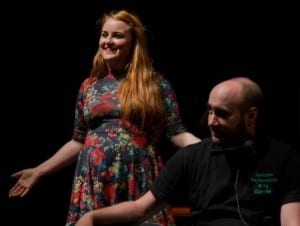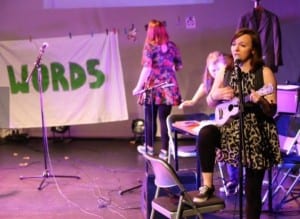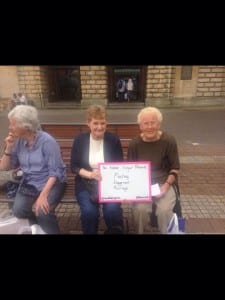(Butler, L. 2014)
So on the 27th of May, we performed our debut performance at the LPAC! Also, Phoebe and I had the daunting task of picking two audience members to be wed! This for me was the scene I was worried about the most, firstly because I had written it and I was worried that no one would laugh but also because of all the things that could have gone wrong. Audience participation is such a tricky subject as you can rehearse different scenarios but you never know how its actually going to happen on the night, but how do people actually feel about audience participation? And how did it go down on the night?
“How restrictive, inhibiting, and alienating for the spectator the sitting area of the classical amphitheatre is can be seen especially in the case of a contemporary interactive theatre event largely based on the collaboration of the public”(Sakellardou, 2014).
On the night, we couldn’t really have hoped for it to have gone any better. Walking into the audience was very daunting and we had to make sure that we chose the right audience member. We wanted two people who had never previously met before and we tried to stay away from choosing a drama student as we wanted somebody who would feel awkward about being on the stage. On the night I think we ended up with a drama student, but this didn’t matter to much as you could still see that they felt awkward about being up there! Making them read the speech ‘We don’t want this wedding’ at the end of the scene contributed to spontaneity of the scene and putting the live feed on our participant added pressure to them, but I also feel it aided our performance because the audience got a live view of his reaction. Audience participation can be labelled as cheesy and also more fitting to pantomime than serious theatre, but I feel the way we and other contemporary shows (such as filter) utilise it gives it a fresh and new feel. We used audience participation to put our point across to the audience without simply just delivering a scene to them. Like filter, we allowed the audience to feel as they were in the scene, and to share the awkwardness with the participants on stage. I think this scene will help us to keep up the spontaneity in this performance if we were to perform it again. As every time it will be different and will reflect the mood of the audience, sometimes it could go wrong but I think that is the beauty of audience participation. ‘Organised chaos’ was one of the main things we wanted to achieve when we set out of devising this show and feel this scene did and will create this again!
Butler, L. (2014)
Works cited
Butler,L. (2014)
Sakellardou, E. (2014) ‘”Oh My God, Audience Participation!”: Some Twenty-First-Century Reflections’, Comparative Drama, 48, 1/2, pp. 13-38, International Bibliography of Theatre & Dance with Full Text, EBSCOhost, viewed 2 June 2014.






